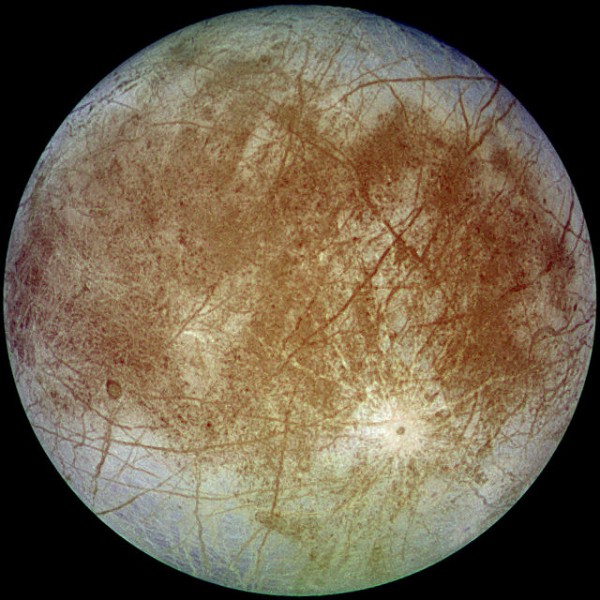
Life on Earth requires a delicate balance of certain chemicals, for example, in the air we breathe. Likewise, seawater needed the right mix of chemicals in order for earthly life to arise. On Earth, the release of gases by volcanoes helps drive the process by which the right chemical mix is created and maintained. It’s not known whether Jupiter’s moon Europa has currently active volcanoes, but the ocean hidden beneath Europa’s icy crust might have an Earth-like chemical balance anyway, without the need for volcanic activity. That’s according to a new study published on May 17, 2016 in Geophysical Research Letters.
If it’s true, the alien ocean on Europa might have the right balance of chemicals for life.
In the new study, researchers compared Europa’s potential for producing hydrogen and oxygen with that of Earth. The balance of these two elements is a key indicator for life. The study found that the amounts would be comparable in scale on both worlds. On both, oxygen production is about 10 times higher than hydrogen production. Steve Vance, a planetary scientist at NASA’s Jet Propulsion Laboratory and lead author of the new study, said in a statement:
We’re studying an alien ocean using methods developed to understand the movement of energy and nutrients in Earth’s own systems.
The cycling of oxygen and hydrogen in Europa’s ocean will be a major driver for Europa’s ocean chemistry and any life there, just it is on Earth.
Researchers calculated how much hydrogen could be produced in Europa’s ocean as seawater reacts with rock in a process called serpentinization. The statement explained:
In this process, water percolates into spaces between mineral grains and reacts with the rock to form new minerals, releasing hydrogen in the process. The researchers considered how cracks in Europa’s seafloor likely open up over time, as the moon’s rocky interior continues to cool following its formation billions of years ago. New cracks expose fresh rock to seawater, where more hydrogen-producing reactions can take place …
The other half of Europa’s chemical-energy-for-life equation would be provided by oxidants — oxygen and other compounds that could react with the hydrogen — being cycled into the Europan ocean from the icy surface above. Europa is bathed in radiation from Jupiter, which splits apart water ice molecules to create these materials.
Scientists have inferred that Europa’s surface is being cycled back into its interior, which could carry oxidants into the ocean.
Scientists have long considered it possible that Europa might have volcanic activity, as well as hydrothermal vents, where mineral-laden hot water would emerge from its seafloor. Researchers had speculated that volcanism is necessary to create a habitable environment in Europa’s ocean. Without volcanic activity, scientists believed:
… the large flux of oxidants from the surface would make [Europa’s] ocean too acidic, and toxic, for life.
But, Vance explained:
Actually, if the rock is cold, it’s easier to fracture. This allows for a huge amount of hydrogen to be produced by serpentinization that would balance the oxidants in a ratio comparable to that in Earth’s oceans.
Read more about the new Europa study from the American Geophysical Union.
Learn more about NASA’s upcoming mission to Europa.

Bottom line: Scientists modeled the ability of Europa’s ocean to produce hydrogen and oxygen without the aid of volcanoes and found that Europa’s potential for producing hydrogen and oxygen is comparable to that of Earth.











